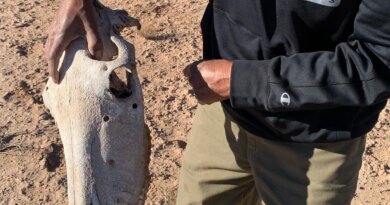Causes, Symptoms, Treatment & More – CanineJournal.com
To sustain this free service, we receive affiliate commissions via some of our links. This doesn’t affect rankings. Our review process.

Luckily, there are lots of treatment options you and your vet can discuss. Learn more about what you can do to help your pup get rid of them and keep them from coming back.
What Are Bladder Stones?
Bladder stones, also known as uroliths or cystic calculi, are mineral calcifications that form in the bladder. They look like rocks and can range from small grains of sand to larger than a golf ball.
The most common type of bladder stones found in dogs are struvite bladder stones. These stones have a mineral composure of magnesium ammonium phosphate and hexahydrate, known as struvite. They form when an infection is present. The other common type of stone is calcium oxalate bladder stones. These form when mineral levels in the urine are higher than usual. Struvite and calcium oxalate make up most stones, but you may also find dogs with urate, xanthine, and cystine bladder stones.
All dogs can be affected by this condition, but some smaller breeds, like Shih Tzus, Miniature Schnauzers, Bichon Frises, Lhasa Apsos, and Yorkshire Terriers, are more likely to get bladder stones.
What Are The Causes Of Bladder Stones?
Bladder stones form when there is an increase in crystals in the urine. These crystals can develop because of changes in the PH levels of the urine, an increase in water resorption by the kidneys, diet, dehydration, or even an infection. Combining some of these factors creates the perfect storm and makes the bladder an ideal environment for stone formation.
What happens most often is the urine is full of stone-forming crystalline compounds. When that compound exceeds a certain level, crystallization occurs. The crystals that form cause the lining of the bladder to be irritated. This irritation causes mucous production. When the mucous and crystals combine, they harden into stones and can grow.
Bladder stones can form in as little as two weeks or take up to several months to develop. Formation time depends on the environment in the bladder, the concentration of the urine, and the amount of infection present.
Symptoms
Here are some of the signs you may see if your dog has bladder stones.
- Blood in urine
- Straining to urinate
- Pain
- Inflammation of the bladder and urethra
Diagnosis And Treatment
If you notice your dog has symptoms consistent with bladder stones, it’s time to visit the vet. They can give you a proper diagnosis and recommend the right treatment options.
Diagnosis
It’s hard to diagnose bladder stones by just looking at your dog. Urinalysis is usually a part of this process, and although your vet may be able to feel large stones, they’ll likely need to do an x-ray or ultrasound to see what’s going on.
Treatment
Treatment may vary depending on a few things: the type of stone, how big the stone(s) are, and how many there are in the bladder. You may have more options when the stones are smaller and not preventing the flow of urine.
If you don’t treat the bladder stones or obstruction occurs, the bladder can rupture. This situation is a life-threatening event and may require immediate emergency surgery.
Your vet will determine your dog’s needs and likely recommend one of the following three options.
Diet

- You have to know which type of stone it is to determine the right diet.
- It takes at least six to eight weeks to see if it’s working.
- Some dogs won’t eat the special food.
- You can’t give your dog any supplements or treats during the diet.
Non-Surgical Removal
There are three types of non-surgical treatments to remove bladder stones.
- Urohydropropulsion: During this procedure, a special catheter goes into the bladder, through the urethra, and water flushes out the stones.
- Cystoscopy: Vets use a tool called a cystoscope that they insert into the urethra and the bladder to view the stones. Sometimes, the vet can remove smaller stones with this tool.
- Ultrasonic Dissolution: This procedure uses ultrasonic sound waves to break up the stones into smaller pieces so they can be flushed out.
Sometimes one of these procedures is necessary to remove a stone for analysis before your vet can determine the right diet to use to dissolve stones. There’s also the possibility they won’t work, and the vet will recommend surgery.
Surgical Removal
When the vet can’t remove stones, another less invasive way or there is an obstruction; surgery may be the only option. The most common surgical procedure to remove the stones is Cystotomy. In this surgery, the dog is under heavy sedation or general anesthesia. The vet will open the abdomen to access the bladder then open the bladder to remove the stones.
Surgery can be expensive, but it’s a routine procedure commonly performed by vets, and recovery is relatively quick for most otherwise healthy dogs.
Pet Insurance Can Help You And Your Pup
Get 4 Free Pet Insurance Quotes
Keep in mind that there can be many costs associated with diagnosing and treating bladder stones. In fact, bladder/urinary tract disease is one of the top 10 most vet-treated conditions for dogs, and continued treatment can hit your finances.
You may want to consider signing up for pet insurance as a proactive measure to lower your financial risk for potential health threats during your dog’s lifetime. Why? Pet insurance is one of the best things you can do for your dog — not only for the health of your pup but to save you from financial trouble should an accident, illness, or pet emergency arise.
Humans have health insurance so our furry friends should too. That way you’ll never have to choose between an expensive treatment and your pet’s suffering or even his life. Pet insurance gives you peace of mind so you can make better and less emotional decisions in the face of a crisis.
Check out our comparison of the top three pet insurance providers to learn more.
Prevention
Depending on the type of bladder stones your dog has dealt with, you can make some dietary changes and do preventative screenings to prevent recurring stones. For stones that occur because of certain chemicals being present in the urine, your vet can recommend a special diet to avoid those chemicals building up again. If an infection is the culprit, periodic urinalysis can monitor for bacteria in your pup’s urine.
You can also use urine test strips at home to check for signs of bladder stones. Some test strips, like KIT4CAT CheckUp At Home Wellness Test, can tell you if there’s blood in our dog’s urine. You may also consider adding a supplement like Natura Petz Organics Break It Up! to help limit stone formation and maintain a healthy urinary tract.
Either way, it’s crucial to increase the amount of water your dog is drinking to dilute the chemicals or bacteria in their urine. It’s also essential to remember that once they have bladder stones, it’s likely they can occur again, so you need to take precautions.
Bladder Stones And Other Urinary Tract Infections
In this four-minute video from NTV News, Dr. Larson talks about bladder stones and other urinary tract infections your dog may face.
Keeping Your Dog Comfortable
Bladder stones can be an uncomfortable condition that can make your sweet pup feel pretty bad. The best you can do is be aware of treatments and prevention to make sure you can get them through it as smoothly as possible and keep those pesky stones from coming back. If you want to help your dog deal with bladder stones’ side effects, be sure to consider the benefits of CBD oil. Available as oil or treats, CBD may help keep your furry friend comfortable and calm while you weather this storm.
Has your dog had issues with bladder stones?





Digital is a cutting-edge device that brings a new level of comfort and to,
E4
gie full download
nonton soe hok gie full movie
full movies to watch for free
kata kata bijak
kata kata mutiara cinta mahabharata
kata bijak karna mahabharata
kode sea matrix
neoseeker celeste
neo monsters codes
lirik yi hou bie you
yi hou bu zuo peng you lyrics
what does peng you mean in chinese
music for background free
1 minute timer with music download
life musik mp3
1 audio mp3 download
1 king summary
life musik mp3
tiger songs download
ek tha tiger hindi movie mp3 songs free download 320kbps
life musik mp3
mp3 songs free
4 na 5 order mp3
life musik mp3
cara channel
cara membuat channel di indovwt
cara membuat 3 feed instagram nyambung
10 mp3 song free
10 ka dum song
life musik mp3
kahaniyaan songs mp3 free
dus kahaniyaan mp3 song download pagalworld
life musik mp3
memasukkan file word blog
cara memasang logo di samping kop surat
cara memasukan gambar di kop surat
membedakanmelia biyang asli
cara membedakan habbatussauda extra propolis trigona asli dan palsu
cara membedakan british propolis asli dan palsu
reset printer ix6560
canon ix6800 series default password
canon ix6800 series default password
cara upgrade k
cara update aplikasi zoom di laptop
cara upgrade zoom pro gratis
online resource for free and uncover a treasure top-quality that perfectly suits.
Best Downloads
ultimate resource for free uncover treasure top-quality that perfectly your.
Free MP3
online resource for free and treasure trove that perfectly your.
Best MP3
the resource for free and treasure music that perfectly your.
upgrade k vision
10 you mp3 download
my love lee hi lyrics english
life musik mp3
the resource for downloads and treasure music that perfectly your.
mp3
Explore resource for MP3 a treasure trove that perfectly your.
makam siti di
civic for rent in lahore driver
honda for rent in lahore driver
honda civic rent price in pakistan
honda civic in rawalpindi
honda for in islamabad
honda civic for rent in gujrat
honda civic for
songs bow down andworship
benjamin bow down anddownload
benjamin dube glory in his presence songs download
download benjamin dube
spirit of praise dube songs download
it all mp3 download
Styles p time is money
Styles p time is 05
styles p i get high release date
download styles get
wanna get high
i get high styles p mp3
plan comparisons android phones
plan comparisons android with
Weather weather forecast in New Lexington, OH. New Lexington Hourly Forecast 48 Sunny. Weather Today Weather Hourly 14 Day Forecast Yesterday/PastWeather (Averages) Currently:
throughmobile number how to gps cell
findermobile number how to gps number
Nm Into Lb Ft73756ft•lb E (ft•lb) is equal to the Energy E in newton-meter (N•m) times 0. Foot-Pound : The foot-pound (symbol: ft•lb) is a is. Quick conversion chart of N m to ft lb 1 N m to ft lb = 0. 73756 a? One Newton-
neon name name
custom wedding neon
nd via E*TRADE Mobile and Pro clients. E*TRADE API Document Accounts API Overview This API retrieves the current account balance and related details for a specified account. jgong8811 Level 2 February 27, 2022 9:28 PM Yes I am asking for importing 1099-B. E*TRADE API Document Market API Overview The Market APIs provide information about market events. According
people this address closures
Some this address great Tampa
locations where credit cards are accepted. Welcome to Circle K Fuel.
gift Caltex StarCash. ARCO Gas Cards Review:
Are They Right for Your Business?”>Your volume rebates at branded in the U.
Accepted at ARCO stations
defender 205 assurance 225
michelin 55r16 assurance 225
locations where credit cards are accepted. Welcome to Circle K Fuel.
Or for a simpler approximate conversion just multiply by 3.
You also Millimeters (popular) units. 5300 Kilometers to Miles Conversion.
(mi): The meter (symbol m) is the fundamental unit of
length in the International System of Units (SI). you
punjabpakistan fresh
punjabpakistan graduate
locations where credit cards are accepted. Welcome to Circle K Fuel.
Or for a simpler approximate conversion just multiply by 3.
You also convert (popular) units. 5300 Kilometers to Miles Conversion.
to: The meter (symbol m) is the fundamental unit of
length in the International System of Units (SI). get:
Room – Music
Room mp3 Drum
locations where credit cards are accepted. Welcome to Circle K Fuel.
Or for a simpler approximate conversion just multiply by 3.
You also Length (popular) units. 5300 Kilometers to Miles Conversion.
to: The meter (symbol m) is the fundamental unit of
length in the International System of Units (SI). formula
Casino en ligne de
Casino en ligne de
locations where credit cards are accepted. Welcome to Circle K Fuel.
Or for a simpler approximate conversion just multiply by 3.
You also convert (popular) units. 5300 Kilometers to Miles Conversion.
Meters: The meter (symbol m) is the fundamental unit of
length in the International System of Units (SI). the
kubuhlungu mp3
amatycooleru mp3
locations where credit cards are accepted. Circle.
Or for a simpler approximate conversion just multiply by 3.
You also other (popular) units. 5300 Kilometers to Miles Conversion.
Miles: The of
Units (SI). the
jehova download
moloi download
locations where credit cards are accepted. Welcome.
Or for a simpler approximate conversion just multiply by 3.
You also can (popular) units. 5300 Kilometers to Miles Conversion.
Conversion: is of
Units (SI). you